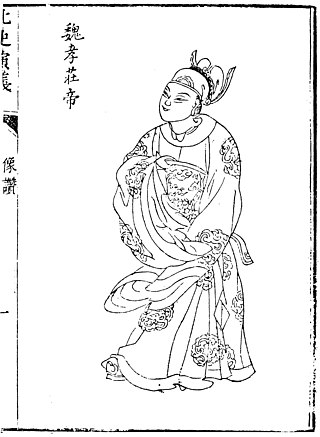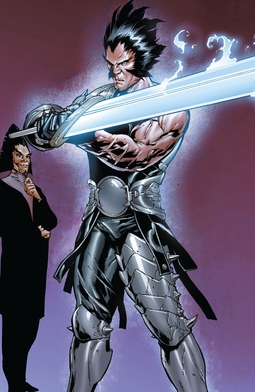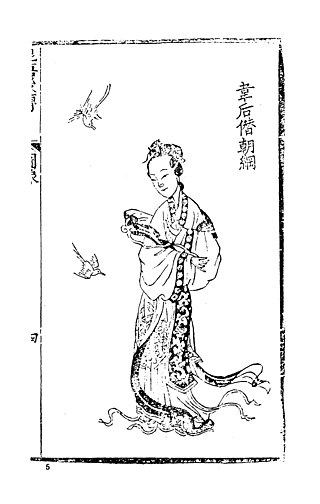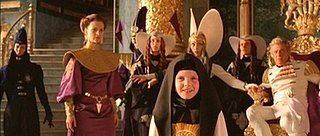
The Rebellion of the Seven States or Revolt of the Seven Kingdoms took place in 154 BC against the rule of Emperor Jing of Han dynasty by its regional semi-autonomous kings, to resist the emperor's attempt to centralize the government further.
Li Chéngqián (李承乾), courtesy name Gaoming (高明), formally Prince Min of Hengshan (恆山愍王), was a crown prince of the Chinese Tang dynasty. He was Emperor Taizong's oldest son and first crown prince, but was replaced later by his younger brother Li Zhi.
Li Tai, courtesy name Huibao (惠褒), nickname Qingque (青雀), formally Prince Gong of Pu (濮恭王), was an imperial prince of the Chinese Tang dynasty.

Emperor Gaozong of Tang, personal name Li Zhi, was the third emperor of the Chinese Tang dynasty, ruling from 649 to 683; after January 665, he handed power over the empire to his second wife Empress Wu, and her decrees were carried out with greater force than the decrees of Emperor Gaozong's. Emperor Gaozong was the youngest son of Emperor Taizong and Empress Zhangsun; his elder brothers were Li Chengqian and Li Tai.

Emperor Yang of Sui, personal name Yang Guang (楊廣), alternative name Ying (英), Xianbei name Amo (阿摩), also known as Emperor Ming of Sui (隋明帝) during the brief reign of his grandson Yang Tong, was the second emperor of the Sui dynasty of China.

The Peshawar Lancers is an alternate history, steampunk, post-apocalyptic fiction adventure novel by S. M. Stirling, with its point of divergence occurring in 1878 when the Earth is struck by a devastating meteor shower. The novel's plot takes place in 2025, when the British Empire has become the powerful Angrezi Raj and is gradually recolonizing the world, alongside other nations and empires that were able to survive. The novel was published in 2002, and was a Sidewise Award nominee for best long-form alternate history.

Emperor Daizong of Tang, personal name Li Yu, né Li Chu, was an emperor of the Chinese Tang dynasty.

Star Wars: The Han Solo Trilogy is a trilogy of non-canon ('Legends') science-fiction novels set in the Star Wars galaxy. It follows Han Solo's origins and life before the events depicted in the original Star Wars trilogy (1977–1983). The trilogy was written by Ann C. Crispin, and released in June 1997, October 1997, and March 1998, respectively. The author stated that "Per Lucasfilm's request, I did not cover Han's time in the Imperial Academy, or his first meeting with Chewbacca"; these events were eventually depicted in the 2018 film Solo: A Star Wars Story.

Emperor Xiaozhuang of Northern Wei, personal name Yuan Ziyou, courtesy name Yanda (彥達), was an emperor of China's Northern Wei dynasty. He was placed on the throne by General Erzhu Rong, who refused to recognize the young emperor, Yuan Zhao, who Empress Dowager Hu had placed on the throne after she poisoned her son Emperor Xiaoming.
Emperor Xiaowu of Northern Wei ( 魏孝武帝), personal name Yuan Xiu, courtesy name Xiaoze (孝則), at times known as Emperor Chu, was the last emperor of the Xianbei-led Chinese Northern Wei dynasty. After the general Gao Huan rebelled against and defeated the clan of the deceased paramount general Erzhu Rong in 532, he made Emperor Xiaowu emperor. Despite Gao's making him emperor, however, Emperor Xiaowu tried strenuously to free himself from Gao's control, and in 534, he, aligning with the general Yuwen Tai, formally broke with Gao. When Gao advanced south to try to again take control of the imperial government, Emperor Xiaowu fled to Yuwen's territory, leading to Northern Wei's division into two. Emperor Xiaowu's relationship with Yuwen, however, soon deteriorated over Yuwen's refusal to condone his incestuous relationships with his cousins, and around the new year 535, Yuwen poisoned him to death. Emperor Xiaowu's successor, Yuan Baoju, is typically regarded, then, as the first emperor of Western Wei, formalizing the division of the empire.
Emperor Shang of Tang, also known as Emperor Shao (少帝), personal name Li Chongmao, was an emperor of the Tang dynasty of China, ruling briefly in 710.
Emperor Xiaozhao of Northern Qi ( 齊孝昭帝) (535–561), personal name Gao Yan (高演), courtesy name Yan'an (延安), was an emperor of the Chinese Northern Qi dynasty. He was generally considered a capable ruler, but ruled for less than two years before dying from injuries suffered from falling off a horse. The Northern Qi dynasty would not have another capable ruler after his death. He was only 26 when he died.
Xiao Xian (蕭銑) (583–621) was a descendant of the imperial house of the Chinese Liang Dynasty, who rose against the rule of the Sui Dynasty toward the end of the rule of Emperor Yang of Sui. He tried to revive Liang, and for several years appeared to be successful in doing so, as he, with his capital at Jiangling, ruled over a state that included most of modern Hubei, Hunan, Guangxi, and northern Vietnam. In 621, however, under an attack by the Tang Dynasty generals Li Jing and Li Xiaogong, he, not realizing that relief forces were approaching Jiangling, surrendered. He was subsequently taken to the Tang capital Chang'an, where Emperor Gaozu of Tang executed him.
Shangguan Yi, courtesy name Youshao (游韶), formally Duke of Chu (楚公), was a Chinese poet and politician. He was an official of the Chinese Tang Dynasty, serving as chancellor during the reign of Emperor Gaozong. In 664, with Emperor Gaozong displeased with his wife Empress Wu for her controlling behavior, and also he grew resentful of her controlling influence in the empire, Shangguan proposed that Empress Wu be deposed, a proposal that Emperor Gaozong was initially receptive to but disavowed once Empress Wu discovered it. Empress Wu then had Shangguan accused of plotting treason with Emperor Gaozong's oldest son, the former crown prince Li Zhong, and Shangguan was executed. Empress Wu then began to attend state assemblies and to oversee the emperor's actions and decisions, hearing all the details of the government and obvious intervening in the government. also, His granddaughter Shangguan Wan'er later served as a key secretary to Empress Wu and a beloved concubine to her son Emperor Zhongzong.

Korvus is a fictional character appearing in American comic books published by Marvel Comics. Korvus uses a weapon known as the Blade of the Phoenix. He made his first appearance in The Uncanny X-Men #478.

Empress Wei was an empress consort of the Chinese Tang dynasty. She was the second wife of Emperor Zhongzong, who reigned twice, and during his second reign, she tried to emulate the example of her mother-in-law Wu Zetian and seize power. She was de facto in charge of the governmental affairs during her husband's reign, though she was not formally regent. Emperor Zhongzong's death in 710 — a death traditionally believed to be a poisoning she carried out together with her daughter Li Guo'er the Princess Anle — made the empress dowager, and she took formal power as regent de jure during the minority of Emperor Shang of Tang. After a reign of seventeen days as regent, she was overthrown and killed in a coup led by Emperor Zhongzong's nephew Li Longji and Emperor Zhongzong's sister Princess Taiping.
Wu Yuanheng, courtesy name Bocang (伯蒼), formally Duke Zhongmin of Linhuai (臨淮忠湣公), was a Chinese poet and politician during the Tang dynasty, serving as a chancellor during the reign of Emperor Xianzong. Wu descended from a family of officials related to Empress Wu Zetian of Zhou and rose in the Tang bureaucracy during Emperor Dezong's reign, holding senior positions in the provinces and at court. After Dezong's grandson Xianzong ascended the throne, Wu became a chancellor and later served with distinction as governor of Xichuan Circuit in modern Chengdu, where he was a patron of the eminent poet Xue Tao. He returned to court in 813 to serve as chancellor and director of the examination bureau, and in that capacity supervised the court's campaign against the Henan warlord Wu Yuanji. On 13 July 815, Wu was assassinated in the imperial capital of Chang'an by agents of Wu Yuanji's ally Li Shidao, the military governor of Pinglu Circuit in Shandong.

Safehold is a science fiction book series by David Weber, currently consisting of ten titles, the latest released in January 2019. The series is mostly set around the 31st century, on a distant world dubbed "Safehold" where a group of humans are in hiding from the Gbaba, an alien enemy responsible for the end of all other human civilization.

Henry VI, a member of the Hohenstaufen dynasty, was King of Germany from 1169 and Holy Roman Emperor from 1191 until his death. From 1194 he was also King of Sicily.

Multiple organizations of the Dune universe dominate the political, religious, and social arena of the setting of Frank Herbert's Dune series of science fiction novels, and derivative works. Set tens of thousands of years in the future, the saga chronicles a civilization which has banned computers but has also developed advanced technology and mental and physical abilities through physical training, eugenics and the use of the drug melange. Specialized groups of individuals have aligned themselves in organizations focusing on specific abilities, technology and goals. Herbert's concepts of human evolution and technology have been analyzed and deconstructed in at least one book, The Science of Dune (2008). His originating 1965 novel Dune is popularly considered one of the greatest science fiction novels of all time, and is frequently cited as the best-selling science fiction novel in history. Dune and its five sequels by Herbert explore the complex and multilayered interactions of politics, religion, ecology and technology, among other themes.
We've a three-point civilization: the Imperial Household balanced against the Federated Great Houses of the Landsraad, and between them, the Guild with its damnable monopoly on interstellar transport.












